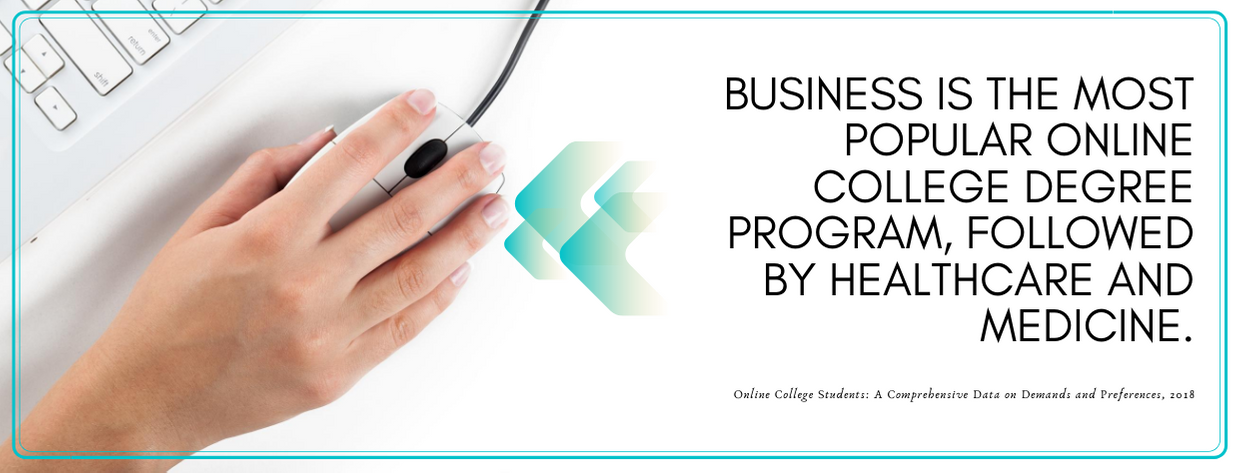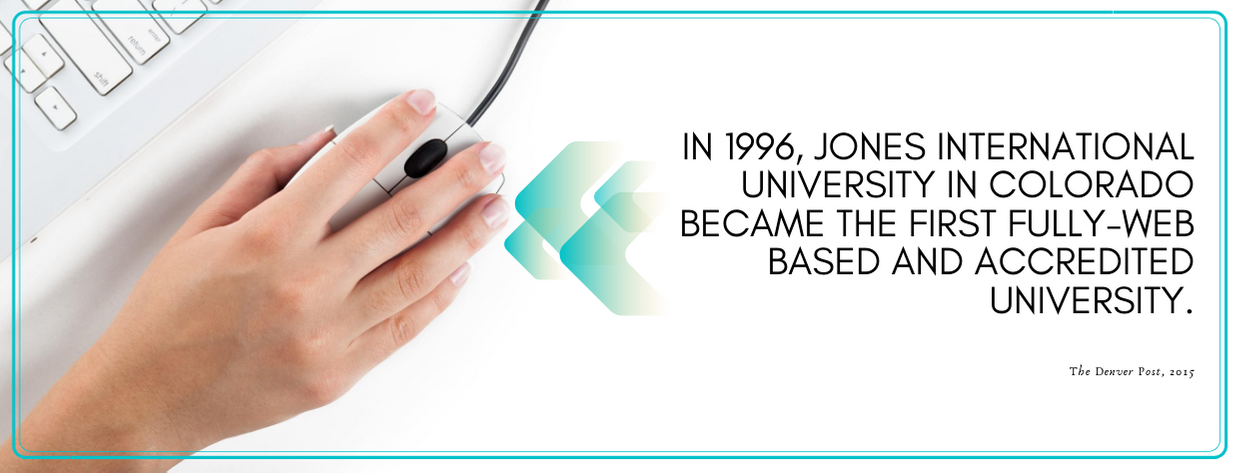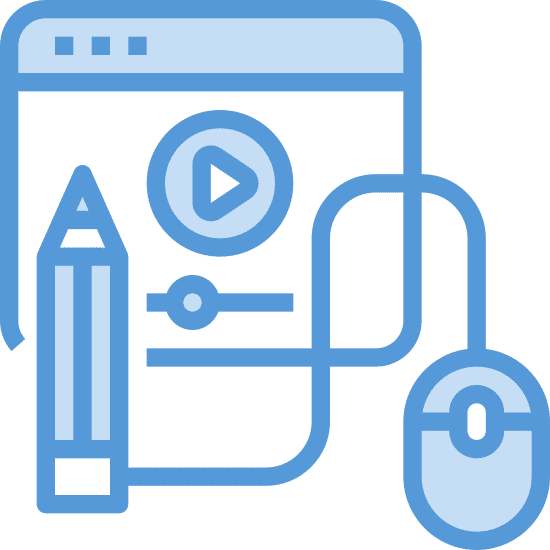Technology has profoundly impacted the way we learn. Decades ago, the quality of acquiring a college degree online was questionable. Classes were once restricted to face-to-face lectures and discussions. Today, thanks to the internet, the trend on education is rapidly changing. It is becoming commonplace for people to take their courses entirely or partly online. Also, more students now work towards their education at their own pace, with lower cost and a variety of choices as online institutions are there to fill such demand.

As eLearning has grown tremendously, the shift from traditional learning to digital education serves as a point of reference for positive change to both the academic and business sectors. Because of its rapid advancement in the current generation of educators and students, the focus is now on enhancing the state of online college degree programs to cater more enrollees.
So if you’re looking for evidence of how eLearning has permeated the education system, check these 100 facts on online college degree programs:
1. Online college degree programs are cheaper than conventional learning methods. It costs an average of $50,000 less than that of on-campus education. (University of Potomac, 2015)
2. Students are more likely to increase their retention rate an online learning environment. A study by the Research Institute of America reveals students retain 25-60% more material when learning virtually than 8-10% in a classroom due to the faster pace in online learning. (Shift eLearning, 2016)
3. Business is the most popular online college degree program. Around 23% of undergraduates and 21% of graduate students are Business students. (Online College Students: A Comprehensive Data on Demands and Preferences, 2018)
4. The second most sought-after online degree program is in the field of Healthcare and Medicine. (Online College Students: A Comprehensive Data on Demands and Preferences, 2018)
5. EVERFI’s “AlcoholEdu for College” is the most extensive single course online. This topic on alcohol abuse prevention currently has more than 10 million students. (Forbes, 2020)
6. Meanwhile, IT and computer graduate courses are the fastest-growing fields. There is evidence of growth by 9% to 15% in 2018. (Online College Students: A Comprehensive Data on Demands and Preferences, 2018)
7. An average online bachelor’s degree costs anywhere between $38,496 to $60,593. After the site ranked their Best Online Bachelor’s Programs, tuition at public institutions for in-state students costs an average of $38,496. It cost $54,183 for out-of-state students, and $60,593 for private universities. (US News & World Report, 2020)
8. North America has the largest eLearning market revenue in the world. It has a projected $18.36 billion revenue in 2020, followed by Asia with $6.85 billion. (Statista, 2016)
9. By 2022, the global eLearning industry’s projected value is at $243 billion. Compared to its $46 billion value in 2016, online education is indeed growing! (Statista, 2016)
10. Since 2000, the digital education market has grown by 900%. The past two decades also saw a 42% increase in revenues of companies. (Procurement Academy, 2017)

11. Asia-Pacific is the fastest-growing region in online education. Additionally, this statistics is expected to grow by 20% annually, utilizing approaches in online tutoring, mobile learning, and video-based learning. (Tech Collective, 2020)
12. In Europe, the UK has the highest e-learning market share. It also has an expected growth of 15% over the next five years as several online education vendors like Adobe Systems and Instructure provide the tools for their online course curricula. (Business Wire, 2019)
13. Schools say the demand for inclusion of an online program is on the rise. Roughly 98% of school administrators perceived that the eLearning market has increased or stayed the same over the past few years. (Online Education Trends Report, 2017)
14. There are more than 100 million registered Massive Open Online Courses (MOOC) students. Enabling online learners to take courses at their leisure for free, everything from science to second languages. MOOC has been popular in the past years! (Learning Revolution, 2019)
15. By 2025, the MOOC industry could be worth $25.33 billion. Following the rise of Udemy, Coursera, Edx, Udacity, and similar platforms, the current market is valued at $5.16 billion and is expected to increase at a yearly rate of 32.05%. (Globe News Wire, 2019)
16. Twenty-two of the top 25 US universities offer free online programs. These American educational institutions allow MOOCs to help with students’ degree completion. (Mordor Intelligence, 2019)
17. Roughly 8 out of 10 US corporations use online learning. About 98% of these American companies want to incorporate them into their future programs. (Small Business Trends, 2017)
18. Half of US e-students take an online college degree program in the same state. This accounts for 56.1% who reside in the same state, with only 0.7% of all distance students taking online enrollments outside the United States. (Grade Increase: Tracking Distance Education in the United States, 2018)
19. America has an average of 32,420 online students per state. With 1.6 million US distance students, most large states with large overall enrollments can accommodate such virtual enrollees. (Grade Increase: Tracking Distance Education in the United States, 2018)
20. California is the US state with the most number of online students. Together with the large states of Texas and Florida, they have over 130, 000 exclusively distance students enrolled in-state. (Grade Increase: Tracking Distance Education in the United States, 2018)

21. Meanwhile, Arizona has the second most number of online students. The state has around 200,000 entrants, many of whom are out-of-state students. (Grade Increase: Tracking Distance Education in the United States, 2018)
22. Nevada has the highest number of in-state online students. The state has 12,645 (93.5%) online enrollment that is located within Nevada’s educational institutions. (Grade Increase: Tracking Distance Education in the United States, 2018)
23. The District of Columbia has the most number of exclusively distance students, followed by West Virginia and New Hampshire. (Grade Increase: Tracking Distance Education in the United States, 2018)
24. West Governors University in Utah is the leading distance learning institution in America. In 2018, there were 121,437 online students in this institution, followed by Southern New Hampshire University (96,912), and the University of Phoenix-Arizona (94,472). (Statista, 2020)
25. The most extensive learning management system (LMS) is Canvas. With a market share of 31.9% in mid-2019, it surpassed Blackboard (29.5%) and Moodle (29.5%), providing virtual learning environments for professors to upload course degree materials online. (Phil on EdTech, 2019)
26. One-third of Americans are enrolled in some form of online education. With approximately 19.9 million US students in college and university, almost 6.9 million of them are enrolled in distance learning. (National Center for Education Statistics, 2019)
27. Most online American students are females, non-military, and US-based. The remaining 35% are males, 10% active service members and veterans, and the final 2% are international students. (US News and World Report, 2017)
28. The average age of a bachelor’s student in an online college degree program is 32 years old. (US News and World Report, 2017)
29. Most online students pursuing a bachelor’s degree are working adults—about 84% of them. (US News and World Report, 2017)
30. Most online students study close to home. Two out of three (67%) e-learning students live within a 50-mile radius of their campus. Around 44% live 25 miles from their university or service center, and 23% live within the 26-and 50-mile distance. (Inside Higher Ed, 2019)

31. Most online students are academic returnees. About 95% of them previously took college courses, and the remaining 5% of new enrollees are first-time students. (US News and World Report, 2017)
32. Graduate schools have the most number of enrollees in digital education. In 2018, 39.8% of graduate students were taking some form of online studies. (National Center for Education Statistics, 2019)
33. There is a rapid increase in the participation of undergraduates in online learning, reaching 34.5% in 2018. This was only 16% in the 2003-2004 academic year. (National Center for Education Statistics, 2019)
34. In 1981, the Western Behavioral Sciences Institute offered the first online college degree program. Located in La Jolla, California, the web-based programs were offered through its School of Management and Strategic Studies. (The Best Schools, 2019)
35. In 1985, Nova Southeastern University offered its first accredited online graduate program. A private university in Davie, Florida, it was one of the first institutions to use telecommunications and computer-mediated communication to reach students. (The Best Schools, 2019)
36. In 1990, FirstClass was recognized as the first real Learning Management System (LMS). A software application for educational technology courses and training, FirstClass supports private and public email forums and allows students to clarify theory presented in learning modules. It was first used by UK’s Open University to deliver online learning across Europe. (Oxagile, 2016)
37. In 1992, the Electronic University Network offered an online Ph.D. degree program. Also, their doctoral degree was offered in partnership with America Online. (The Best Schools, 2019)
38. In 1994, CALCAMPUS launched its first online curriculum. It offered online college courses with real-time instruction and participation, in the synchronous learning format. (The Best Schools, 2019)
39. In 1996, the first fully-web based and accredited university was Jones International University. This educational institution in Colorado was accredited by the Higher Learning Commission and a member of the North Central Association. (The Denver Post, 2019)
40. In 1997, California Virtual University offered more than 1,000 online courses. This enabled students to search and enroll in online courses offered at California Community Colleges. (Grow Enrollments, 2020)
41. In 1999, the term “e-learning’ was coined. Elliot Maise used this word in a professional context at his TechLearn Conference at Disneyworld. (Shift eLearning, 2014)
42. In 2002, the Massachusetts Institute of Technology (MIT) was one of the first universities to publish free online educational resources. The private institution in Cambridge made a web-based publication called OpenCourseWare, where all course contents were made virtually available to online students. (The Best Schools, 2019)
43. Also in 2002, Moodle was released as the first open-source LMS. Remaining as one of the most popular open-source LMS available today, it allows users to only download the software back then. (Oxagile, 2016)
44. In 2007, the first-ever MOOC was launched. Named Advance Learning Interactive Systems Online (ALISON), the site has now claimed more than 15 million learners to date. (Grow Enrollments, 2020)
45. In 2011, the US Department of Education regulated the standardization of online schools. Instead of factoring in student competencies or other educational measures, credit hours were mandated to satisfy all state-level academic requirements. (The Best Schools, 2019)
46. In 2013, the University of Florida-Online became the first online-only public institution. At present, it offers both online undergraduate and graduate degrees. (The Best Schools, 2019)
47. The University of Pennsylvania was the country’s first Ivy League university to offer a fully online bachelor’s degree program. The degree in Applied Arts and Sciences was offered through the College of Liberal and Professional Studies. (The Philadelphia Inquirer, 2018)
48. Public institutions educate the largest proportion of online students. Enrolling two-thirds of US students, public colleges and universities had the highest growth in online course enrollment at 7.3% between fall of 2015 and 2016. (US News and World Report, 2018)
49. Ohio State University is the highest-ranked online bachelor’s program. The methodology used for undergraduate programs were based on four factors (Engagement, Services and Technologies, Faculty Credentials and Training and Expert Opinion) and made up of various measures that were reported by institutions or accumulated from peer survey. (Forbes, 2020)
50. The second highest-ranked online bachelor’s program is Embry-Riddle Aeronautical University (FL). Consequently, the University of Illinois- Chicago reaps the third spot with the University of Florida and Oregon State University landing in the fourth and fifth, respectively. (US News and World Report, 2020)

51. The University of North Carolina-Chapel Hill and Indiana University-Bloomington share the top spot for best online graduate MBA programs among the 335 colleges ranked by U.S. News in 2020. Third on the list is Carnegie Mellon University in Pennsylvania. (U.S News, 2020)
52. For non-MBA, the best online graduate programs are from the University of Southern Carolina. It bested other 187 colleges, followed by Indiana University and Villanova University (PA). (Forbes, 2020)
53. In the field of Nursing, Rush University (IL) has the best online degree program out of 183 institutions. University of South Carolina and Johns Hopkins University are also on the list. (Forbes, 2020)
54. Online schools attract students through multichannel advertising and marketing approaches. From traditional marketing efforts such as television commercials (30%) and college fairs (23%) to digital channels like search engine listings (31%), these multiple formats greatly benefit online colleges and universities. (Online College Students: A Comprehensive Data on Demands and Preferences, 2018)
55. The school website is the primary source of information for online programs. Prospective students also conduct internet search engines (34%), make phone calls to schools (23%), ask friends and family (21%), and check out printed school materials (18%). (Online College Students: A Comprehensive Data on Demands and Preferences, 2018)
56. An average student reaches out to 2.5 schools for information about their online degrees. About 59% of these online learners are graduate students. (Online College Students: A Comprehensive Data on Demands and Preferences, 2018)
57. After starting the search process, college e-learners apply to school within weeks. (Online College Students: A Comprehensive Data on Demands and Preferences, 2018)
58. Multimedia presentations are ingredients for online learning success. Nearly two-thirds (58%) of students stated that videos and PowerPoint presentations from professors helped them learn better. Others say textbooks (52%) and written assignments (51%) make learning easier. (Online College Students: A Comprehensive Data on Demands and Preferences, 2018)
59. Four-year schools fund online education more than two-year institutions. In 2019, 48% of four-year colleges increased their budget for online programs while only 41% of two-year schools did. (EducationData.Org, 2020)
60. 4 out of 10 online faculty members have taught in online classes for less than five years. About 25% of them have been at it for at least 10 years. (EducationData.Org, 2020)
61. The majority of online professors built their courses. Only 17% of these instructors utilized online classes developed by an instructional designer. (EducationData.Org, 2020)
62. There is a low student-to-professor ratio in e-learning classrooms. To get more individual feedback and more focused instruction, 97% of these online schools maintain a 25:1 student to professor ratio. (University of Potomac, 2015)
63. 4 out of 5 online school administrators choose to create an online program because they want to extend their on-campus programs to distance learners. About 73% reported that there is a demand from interested students in specific subject areas or degree levels. (Online Education Trends Report, 2017)
64. Almost half of the instructors taught an online course for credit in 2019, compared to only 36% in 2016. (EducationData.Org, 2020)

65. Most online instructors teach a hybrid course format. In 2019, 38% of them allowed students to study course materials outside class and utilized up to 50% of online classroom time for instructions, assignments, and discussions. (EducationData.Org, 2020)
66. The biggest challenge in launching new online programs is meeting marketing and recruiting goals. About 4 out of 10 school administrators face with this daunting task. Around 31% stated meeting costs and program management demands was the biggest hurdle, while 8% said they had the hardest time helping students reach their academic goals while making their online program profitable. (Online Education Trends Report, 2017)
67. Online students want program outcomes data on placement and employment rates. This information sets the traditional benchmark for online program success. (Online Education Trends Report, 2017)
68. Nearly half of virtual students want to enroll in additional college degree programs. About 47% of them expressed that, after earning their current degree, they are planning on enrolling in other courses from other online schools. (Inside Higher Ed, 2019)
69. Tuition costs and fees is a top-ranking factor in deciding on an e-school. One of three online students reported so, and others considered the reputation of the program (13%) or the school reputation and proximity of the school (11%). (Online College Students: A Comprehensive Data on Demands and Preferences, 2018)
70. Most undergraduates pay $300 to $600 per-credit tuition cost for their online program. Roughly 37% of online students reported this. Others paid $300 or less (33%), and the rest paid up to $800 (20%) per credit. (Online College Students: A Comprehensive Data on Demands and Preferences, 2018)
71. At the graduate level, the most common tuition rate is $800 or more per credit. This is due to the specialized nature of these programs, especially on STEM majors, computers, and IT courses. (Online College Students: A Comprehensive Data on Demands and Preferences, 2018)
72. One-third of online students were awarded credits from Prior Learning Assessments (PLAs). PLAs grant credits for life or work experiences. (Online College Students: A Comprehensive Data on Demands and Preferences, 2018)
73. Scholarships attract students to online programs. These features help draw and retain 31% of online students. Others prefer short, 12-month courses (27%) and self-paced courses (25%). (Online College Students: A Comprehensive Data on Demands and Preferences, 2018)
74. Transfer credits are also a decisive factor for online college students. Roughly 9 out of 10 undergraduates have credits that can be transferred to their next college degree program. (Online College Students: A Comprehensive Data on Demands and Preferences, 2018)
75. Career advancement is the primary motivator of online students (17%). Others had enhanced job-related skills (16%), pay raise (13%), and employment requirement (10%) as reasons for enrolling in online classes. (Online College Students: A Comprehensive Data on Demands and Preferences, 2018)
76. More than half of online students prefer a program of study that they are familiar with. Over one-third (36%) of them know about the general field but not the specific online program before they enroll, and 9% have not narrowed down what they want to study. (Online College Students: A Comprehensive Data on Demands and Preferences, 2018)
77. Paying for the remaining courses in an online college program is the top roadblock for graduating online students. Other limitations include access to technology or internet connectivity, on-campus visits for program support (testing, orientation, tutoring), and a minimum GPA requirement. (Online Education Trends Report, 2017)
78. More than half of online students are enrolled part-time. By contrast, 47% of virtual learners were full-time enrollees. (Online Education Trends Report, 2017)
79. Most eLearners (36%) are drawn toward earning an associate degree. Some 30% are seeking to earn a bachelor’s degree, 17% are in it for industry certification, and 5% are aiming toward their MBAs. (Online Education Trends Report, 2017)
80. Most US students who are pursuing an online college degree program are Whites. These 7 out of 10 students are followed by Blacks (10%) and Hispanics (6%). (Online Education Trends Report, 2017)

81. Half of US graduate students have better experience in online education than classroom-based learning. Roughly 38% reported that their distance college-level distance learning experience is just the same as face-to-face education. (Statista, 2019)
82. Around 38% of students read online reviews from students when researching online schools. About 36% of them research college websites and 31% contact the schools directly. (Online Education Trends Report, 2017)
83. Before enrolling in an online program, most students research for related professional associations. Around 34% of them check out employment and salary data from government agencies. (Online Education Trends Report, 2017)
84. Most students prefer cyber schools because they fit best with their current work-life responsibilities. About 34% of them stated that virtual classrooms are their preferred method of learning. (Inside Higher Ed, 2019)
85. Students find online school useful in managing their course schedules. Some 36% of them stated that online learning helps them keep track of their class schedules and staying organized. (Statista, 2020)
86. 4 out of 10 online students say that eLearning is helpful, citing ease and convenience of the learning process. (Statista, 2020)
87. The online learning method can help college students perform better in class. Over 8 in 10 (81%) virtual students reported that it helped improve their grades. (Statista, 2020)
88. Online students prefer mobile devices in completing their course-related activities. Nearly three in five students under 45 years of age reported this. (Inside Higher Ed, 2019)
89. Online college students prefer the textbook-free approach in online schools. Students say this cost-effective practice also helps them get through the course better. (Online College Students: A Comprehensive Data on Demands and Preferences, 2018)
90. Online college students are satisfied with their enrollment process. Additionally, 44% of the enrollees stated that they would not change any part of it. (Online College Students: A Comprehensive Data on Demands and Preferences, 2018)

91. Online education programs are aimed at returning adult US students, who make up 79% of their target student population. (Statista, 2020)
92. In 2017, nearly half of online learners never visited a campus. Meanwhile, 22% of virtual students attended classes entirely online and sometimes visited their campus. About 21% of students’ courses required in-person or on-campus meetings. (Online Education Trends Report, 2017)
93. “Compare more programs” is the most offered advice you’ll hear from online alumni. Other online students wished they followed the advice to research more about cost and financial aid (25%), consider credit transfer programs (18%), speak with employers or field professionals (16%), and have better technological resources (15%). (Online Education Trends Report, 2017)
94. Online courses reduce greenhouse gases by 85%. It also consumes 87% less energy and emits less CO2 per person than traditional learning, according to a study by The Open University comparing the environmental impacts of both. (Open Research Online, 2008)
95. The e-learning industry is now 2I years old. It’s only a year older than the launch of Google, and both are still moving forward! (Shift eLearning, 2014)
96. What’s new? Africa has rolled out eLearning for farming. Designed for their farming and food sector, it delivers information and training about markets, sources and prices of finance, crop management, animal husbandry, and farm business development among others for a prosperous future. (Entrepreneur South Africa, 2019)
97. The majority of online students report achieving their primary goal, which gave them the motivation to enroll. This was strongly agreed by 67% of online college students. (Online College Students: A Comprehensive Data on Demands and Preferences, 2018)
98. Social interaction is a critical factor for online learning success. Despite seeking an individualized and “learning on my own” educational experience, 57% of both past and present e-learners agree that their classmates’ interaction and relationship are crucial to their online learning success. (Online College Students: A Comprehensive Data on Demands and Preferences, 2018)
99. Eight out of 10 online students report improvement in the mastery of “soft skills.” These current and former e-learners agreed that they made progress with their problem-solving and critical thinking skills, time management, and attention to detail. (Inside Higher Ed, 2019)
100. In the end, an online degree’s value is more than its price. This was strongly agreed by eight out of 10 current and former fully distance learning students. (Inside Higher Ed, 2019)

The Future of Online Learning
Online student enrollment is increasing faster than the number of classrooms being built, and students are becoming more proficient than ever in technology. With more software improvement, time management apps, and better internet accessibility on the horizon, extensive educational options will be available online!
With that said, eLearning is not expected to slow down anytime soon and will remain a big part of the higher education sector. In fact, digital education is the future. In the next decades to come, virtual classrooms will be here to stay!